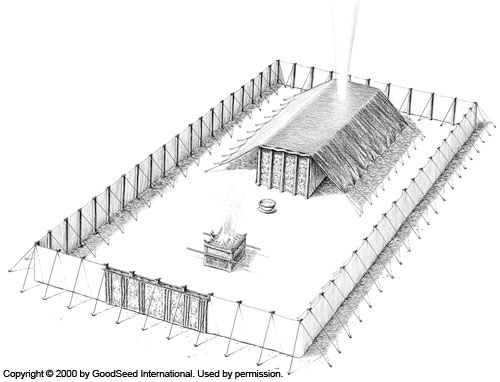Why Study the Tabernacle of Moses?

What is the Tabernacle of Moses?
- Diagrams of the Tabernacle and Basic Layout
- The Gate
- The Brazen Altar
- The Laver
- The Menorah
- The Table of Showbread
- The Golden Altar of Incense
- The Ark of the Covenant and Atonement Cover
Why Study the Tabernacle of Moses?
Why the Jewish Old Testament Tabernacle?
Sunday School Lessons on the Tabernacle
As modern-day readers of the Bible, we tend to skim over the detailed and often tedious texts of the Old Testament and focus instead on the simpler sections of the New Testament. It is tempting to relegate the 50 chapters in the Books of Moses devoted to the tabernacle as irrelevant or boring. After all, how are all the intricate plans for a 15th century B.C. collapsible structure useful to us as 21st-century Christians?
The wilderness tabernacle — an outdated concept?
Just like Jesus’ parables served to illustrate and bring His teachings to life, so the Old Testament visuals serve to illuminate many spiritual concepts in the New Testament.
By omitting the tabernacle of Moses in our teaching, we are actually neglecting a powerful and necessary tool that God had prepared for us to understand the work of Christ on the cross.
It was in the tabernacle that God pictured what was required for man to become right with Him. The detailed commands that God gave the Israelites for the setting up of the tabernacle demonstrate to us God’s holiness — in order for sinful man to approach a holy God, he must come to God in God’s own prescribed way, and no other way.
The blood sacrifices — a picture of Christ’s sacrifice
At the same time, the tabernacle also is a compelling symbol of God’s forgiveness and grace. Through the sacrifices of sheep and goats, God sees the blood and passes over the sin of the people until the coming of Christ, the ultimate sacrifice.
To fully appreciate Christ’s sacrifice for us, we need to be familiar with this tabernacle sacrificial system. Why did John the Baptist declare, “Behold, the Lamb of God!” when he saw Jesus? It is difficult to understand why the Messiah would be associated with a weak and defenseless animal until one considers the sacrificial system. It was no coincidence that Jesus’ death occurred at the very time that sheep were being slaughtered for the evening sacrifice at the Jerusalem temple. Understanding what happened on the brazen altar in the temple is key to understanding what happened on the cross.
The temple curtain — a physical image of separation
Another amazing symbol surrounding Christ’s death is the tearing of the temple curtain from top to bottom. That event is meaningless unless we understand why the curtain was there in the first place and what exactly it was separating — a holy God from sinful man. To see that, we need to be able to visualize the physical layout of the temple. And the origin of the temple itself is difficult to explain apart from its prototype — the mobile tabernacle given to the Israelites in the wilderness.
The priesthood — a projection of Christ’s role
It is also impossible to talk about the life of Christ without encountering the Israelite priesthood, which originated in God’s commands to Moses for the tabernacle. And why is Jesus so often referred to as our “high priest” in the New Testament? Invariably, you are forced to go back to the tabernacle to explain the nature and purpose of the priesthood.
Teaching visually using the tabernacle model
The above are just a few of the many insights that the tabernacle offers for the early Christians and to us today. The tabernacle is a compelling and indispensable visual aid for explaining Christ’s work on the cross. Its physical structure, “a copy and shadow of heavenly things” (Hebrews 8:5), teaches us spiritual lessons about eternal truths.
“For Christ did not enter a man-made sanctuary that was only a copy of the true one; he entered heaven itself, now to appear for us in God's presence.” (Hebrews 9:24)
So why have we so often failed to realize its significance? I think part of the answer can be found in the difficulty of communicating with words what was meant to be taught visually. The tabernacle is best learned by seeing rather than hearing. It is our hope that this small tabernacle of Moses model will excite an interest and desire to learn more about the greatest of visual aids.
How to teach the tabernacle and what the sacrifices picture?
The wilderness tabernacle model can be used to teach all ages in any setting. The model speaks for itself, but it is helpful to have some resources on hand to explain the various pieces of furniture and parts. Besides what we have laid out on this site, an excellent resource is the description found in Chapter 9 of the book The Stranger on the Road to Emmaus and By This Name, great evangelism, bible study and discipleship tools. We recommend reading through the whole book as it gives a detailed yet easy-to-understand overview of the history of Israel and how the Old Testament leads up to and is fulfilled in the work of Jesus Christ. As demonstrated above, a clear understanding of Old Testament tradition is imperative to understanding the accomplishment of Christ.

I WANT TO LEARN
ABOUT GOODSEED
The Monthly
GoodSeed eNewsletter
Sign up to receive articles, testimonies, sneak peeks of new resources & upcoming seminars. You'll receive a PDF copy of The Tabernacle: Model of Messiah as a thank you for partnering with us.
© 2023 GoodSeed International. All rights reserved.


